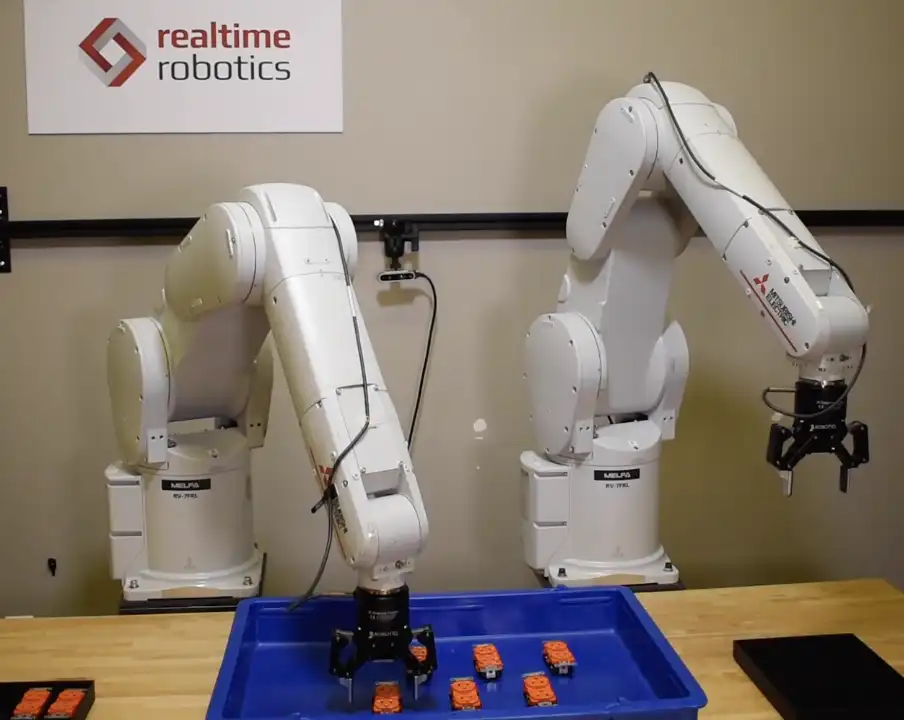
Insights
Improving Bin Picking Performance
There is a great opportunity to have multiple robots work together in many application domains, including manufacturing and logistics. The potential performance advantage of being able to use multiple robots is similar to the benefits of being able to use multiple people to complete a task.
Using a standard bin picking application as a case study, we’re going to explain why current technology can’t take much advantage of this opportunity. But first let’s see where a single-robot gets bottlenecked, so that we better understand how multiple robots could provide benefit.
One Robot Per Task
Single Robot Bin Picking
This video shows a single robot picking parts out of an assembly bin and placing them in a package for shipment. Due to several performance bottlenecks, which are highlighted below, the robot performs this task more slowly than a person, and this poor performance limits the adoption of automation.
There are four performance limiting factors with one robot working on a task with conventional off-the-shelf methods:
- Physical limits: The time required to do each pick and place is based on the distance, speed and acceleration of the robot and processing data with conventional off-the-shelf methods. The most promising solution to increase performance is to add more robots, but this only helps if those robots can work collaboratively.
(More on this later!) - Gripper performance: There is some period of time during which the robot must stop moving in order for the gripper to open or close when picking and placing. As gripping technology continues to incrementally improve, gripping time will decrease.
- Perception performance: In this application a structured light camera is used to locate up to 8 parts inside the bin and provide pick poses for them. As camera technology improves, they will be able to provide targets and poses more quickly.
- Robot motion planning: When a pick pose is provided to a robot, there is some delay as the robot makes a motion plan to get to that pose. Motion planning has been a longstanding bottleneck in robotics, and it can take several seconds to perform using prior technology. Realtime Robotics has the only solution for eliminating this crucial bottleneck.
(More on this later!)
Two Robots Per Task
Multi-Robot Bin Picking with Interlocks
In theory, adding a second robot should double the performance of the workcell, but practice and performance is far from theory. Instead of achieving ideal linear speedup as we add robots, we get the poor marginal gains of the “Current reality” blue curve.
Why is the marginal benefit of the second robot so limited? Because the robot motions must be coordinated to not collide with each other when picking. This process is extremely challenging for robot programmers, which is why the industry standard solution is conservative and leaves a lot of performance on the table.

The current industry approach is to introduce the concept of an interference zone, or an area where only one robot is allowed to be at any time. In a workcell, any region that is reachable by more than one robot is its own interference zone. In our example, an interference zone is designated above the blue bin, meaning only one robot can be above or in the bin at one time. This ensures the robots will not collide with each other, because while the first robot is picking the second robot is waiting outside the interference zone.
Specifically, even if more than one robot could have safely been in separate parts of the interference zone, that would be prohibited. In our application, one robot idles while the other robot makes a pick.
Two Robots with Realtime’s Technology per Task
Multi-Robots Bin Picking with Realtime Technology
The key to optimal performance is having both robots work simultaneously. The Realtime Controller actively monitors the robots and the workspace to generate collision-free plans in real-time. With both robots being able to have safe, close movements the need for conventional interference zones is eliminated. The result is dramatically increased throughput, because robots are not needing to idle when the other is within the interference zone.
The Upshot: How Much More Performance?
For specific performance impact on how much performance was gained, we ran four trials with each scenario. The table below shows the average performance of all the trials. The Realtime Controller achieves a 74% higher performance than the single-robot baseline, whereas using interference zones achieves only 14% higher performance.
